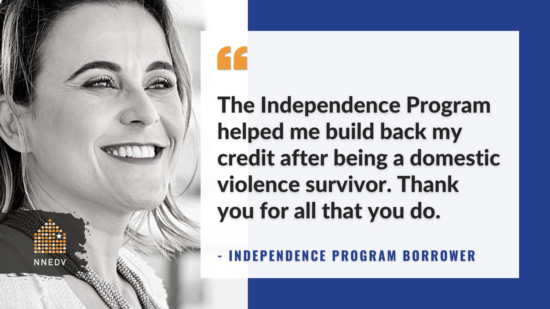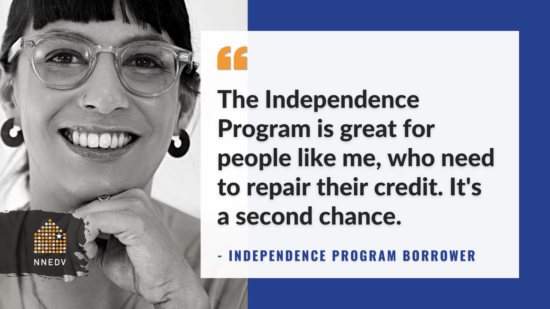Independence Program
What is the Independence Program?
Established in 2017 and formerly known as the Independence Project, NNEDV’s Independence Program provides credit-building microloans to survivors of financial abuse in all U.S. states, territories, and the District of Columbia to help them build or establish credit. Since its inception, more than 1,010 Independence Program borrowers have successfully completed a First Step microloan, with an average credit score increase of 18 points and an average credit score upon completion of 648.
Personal safety and economic security are inextricably linked. A survivor with a low credit score may have trouble securing housing, obtaining a new job, or even purchasing essential goods and services, like a vehicle or a cell phone. When a survivor builds her credit score, she is building economic resiliency, making it much more likely she and her family can move from short-term safety to long-term security.
Through the Independence Program, advocates and local domestic violence programs across the nation support domestic violence survivors working to improve or establish their credit scores through microlending.
The Independence Program was established in partnership with Verizon and with seed funding from Thirty-One Gifts and is supported in part by generous funding from the Kering Foundation, The Allstate Foundation, and Bread Financial.

How does the Independence Program work?
Independence Program applications are temporarily closed. Applications will reopen on this page on January 12, 2026.
*At this time, Independence Program loan products are not available to residents of Louisiana, Maryland, or Ohio.
The Independence Program offers three survivor-centered lending products:
(1) First Step Loan (FSL): Credit-building loan for survivors to rebuild or establish credit.
- $100 loan with 0% interest and $0 fees
- $10 monthly payments for 10 months
- Borrowers must have met with a DV advocate at least three times and provide a monthly budget showing their ability to repay the loan.
(2) Next Step Loan 500 (NSL500): Asset-building loan for survivors to continue toward financial goals.
- $500 loan with 0% interest and $0 fees
- $27.78 monthly payments for 18 months
- Borrowers must first successfully complete a First Step Loan (FSL) and provide a monthly budget showing their ability to repay the loan.
(3) Next Step Loan 1000 (NSL1000): Asset-building loan for survivors to continue toward financial goals.
- $1,000 loan with 0% interest and $0 fees
- $41.67 monthly payments for 24 months
- Borrowers must first successfully complete a First Step Loan (FSL) and provide a monthly budget showing their ability to repay the loan.
Eligibility for Next Step Loans:
- Must have successfully completed the First Step Loan (FSL) within the last 5 years.
- FSL loan may not have more than two (2) missed payments. Payments are considered ‘on-time’ as long as the payment is made within the month it is due.
- If paid off FSL early, at least six (6) payments must have been made.
- Note: Applicants cannot have more than one Next Step Loan at once.
As of September 2025, Next Step Loans are currently available only in Alabama, Alaska, American Samoa, Arizona, California, Colorado, Connecticut, Delaware, Florida, Georgia, Guam, Hawai’i, Illinois, Kansas, Kentucky, Indiana, Maine, Massachusetts, Michigan, Minnesota, Nevada, New Jersey, Northern Mariana Islands, Oregon, Puerto Rico, South Carolina, South Dakota, Tennessee, Texas, Utah, Vermont, Washington, Wyoming, and the U.S. Virgin Islands.
Please click here to view a printable Independence Program brochure with additional details.
To achieve the best possible credit score improvements through this program, the survivor must repay consistently until the loan matures. NNEDV tracks each repayment made by the survivor and reports each payment to the three credit bureaus, which helps establish or build credit history. The success of the program is incumbent upon each borrower’s commitment to loan repayment.
Using a trauma-informed approach, the Independence Program team practices high-touch, compassionate lending to help borrowers build financial confidence and a better understanding of the financial system. Our team helps borrowers navigate the online loan application and borrower portal, collaborates with advocates, and offers flexibility in repayment to assist borrowers in building a positive relationship with finances.
The Independence Program team is data-driven, surveying each loan completer to learn about their experience and inform efforts to build better products for survivors in the future.
 In collaboration with research partners at Temple University, we are evaluating the impact of the Independence Program! Accepted applicants interested in participating will be contacted by the research team and will be compensated up to $160 for their participation.
In collaboration with research partners at Temple University, we are evaluating the impact of the Independence Program! Accepted applicants interested in participating will be contacted by the research team and will be compensated up to $160 for their participation.
This project was supported by Grant No. 15JOVW-22-GG-04762-MUMU awarded by the Office on Violence Against Women, U.S. Department of Justice. The opinions, findings, conclusions, and recommendations expressed in this publication/program/exhibition are those of the author(s) and do not necessarily reflect the views of the U.S. Department of Justice.

What happens after I apply for an Independence Program loan?
Once you sign up and create an account, please complete the Independence Program application. The application consists of the following:
- General information and consent;
- Borrower monthly income and expenses information;
- Method of payment and loan disbursement information; and
- A form completed by an advocate providing contact information and confirmation the borrower has met with the domestic violence advocate at least three times.

What is the average Independence Program borrower like?
Of all Independence Program participants, 17% report being unbanked, 81% are earning less than $30,000 a year, and 34% are earning less than $15,000.
The majority of Independence Program borrowers used their loans to pay towards their bills or utilities.
This is a significantly underserved population that, as a result of being unbanked/underbanked, face burdensome financial service costs, oftentimes seen through coerced dependence on predatory, payday lending, and limited access to credit and credit-building opportunities. Approximately 30% of borrowers reported that, before enrolling in the Independence Program, they had no access to credit education, financial literacy, resources, or ethical lending.
The majority of Independence Program borrowers are housing insecure; 56% are in temporary housing or shelters and 18% are living in emergency shelters.

How can financial abuse impact a survivor’s credit score?
Almost all domestic violence survivors have also experienced financial abuse. Financial abuse includes tactics to conceal information, limit the victim’s access to assets, or reduce accessibility to the family finances, such as controlling all the household finances, as well as ruining a victim’s credit, running up debt in a victim’s name, or preventing a victim from working. It may involve the abuser preventing the victim from accessing or using a bank account or a credit card, or exploiting the victim’s economic resources through job sabotage or identity theft.
Financial abuse is one of the most powerful methods of keeping a person trapped in an abusive relationship and deeply diminishes their ability to stay safe if they leave an abuser.
Experiencing financial abuse can prevent survivors from finding housing, securing a job, and providing for the basic needs of themselves and their children. Without access to these essential building blocks for a safe, happy life, women are often faced with the impossible choice to stay with, or return to, an abusive partner, just to keep themselves and their children fed and housed.
Victims often cite financial abuse as the main reason they stayed with or returned to an abuser
For a survivor seeking safety, a ruined credit score is one common setback from financial abuse and a barrier to securing overall safety. With a low credit score (typically defined as a score below 620), a survivor may experience difficulty qualifying for a credit card or a loan, securing housing, obtaining a new job, or even purchasing essential goods and services, like a vehicle or a cell phone. On the other hand, with a good credit score (typically defined as a score above 700), some of the most important economic resources, like credit cards and bank loans, become more accessible and may offer lower interest rates.

How can I learn more about the Independence Program?
To learn more about the Independence Program, apply above, view the printable brochure or contact NNEDV via email.
NNEDV is grateful to Bread Financial, the Kering Foundation, and The Allstate Foundation for their Independence Program support and partnership.
LOAN RATES AND FEES
BELOW IS GENERAL INFORMATION REGARDING ALL RATES AND FEES THAT WILL ASSIST YOU IN MAKING YOUR LOAN DECISION. IF YOU HAVE ANY QUESTIONS, OR WOULD LIKE MORE INFORMATION, PLEASE ASK. MAKE CERTAIN THE QUESTIONS THAT YOU ASK ARE ANSWERED. MAKE CERTAIN YOU UNDERSTAND THE TERMS AND COSTS OF YOUR LOAN.
ANNUAL PERCENTAGE RATE (APR)
The cost of your credit as a yearly rate. APR is a combination of the interest rate plus the fees charged on your loan. APR is higher than the interest rate because it includes both fees and interest as finance charges.
Your actual terms and the Annual Percentage Rate (APR) will be determined at the time your application is submitted and will be based upon your application and credit information. Not all applicants will qualify for the lowest rate.
The calculation of APR is mandated pursuant to Federal Law (12 CFR Part 1026 – Truth in Lending Act (“TIL-APR”)). It is intended to provide a single value for a consumer to compare the cost of credit between one lender and another. Under New Mexico law, an additional type of annual percentage rate (“NM-APR”) must be disclosed, which may include additional charges that are not included in the TIL-APR. The NM-APR for a loan in an amount of more than $500 and up to $10,000 made pursuant to the Small Loan Act of 1955 or the Bank Installment Loan Act of 1959 cannot exceed thirty-six percent. The NM-APR for a loan in an amount of $500 or less made pursuant to the Small Loan Act of 1955 or the Bank Installment Loan Act of 1959 cannot exceed thirty-six percent plus a fee that shall not exceed five percent of the total principal of the loan and shall not be imposed on any borrower more than once per twelve-month period.
FEES
A list of all additional fees that you may be charged.
0% APR
$0 Fees
NEW MEXICO ONLY: TO REPORT A PROBLEM OR COMPLAINT WITH THIS LENDER, YOU MAY WRITE OR CALL:
Kim Pentico
Economic Justice Senior Director
National Network to End Domestic Violence (NNEDV)
1325 Massachusetts Ave NW, 7th Floor, Washington, DC 20005-4188
(202) 543-5566 x 108
EJ@NNEDV.org
New Mexico Only: This lender is licensed and regulated by the New Mexico Regulation and Licensing Department, Financial Institutions Division, P.O. Box 25101, 2550 Cerrillos Road, Santa Fe, New Mexico 87504.
To report any unresolved problems or complaints, contact the Division by telephone number (505) 476-4885 or visit the website: https://www.rld.nm.gov/financial-institutions/
- 02381 SL License
- Consumer Information – Common Terms and Definitions
- Consumer Information Brochure Sample
OHIO ONLY: If you have any complaints against National Network to End Domestic Violence (NNEDV) contact Ohio Department of Commerce, Division of Financial Institutions at 77 South High Street, Columbus, Oh 43215. (614)728-8400.

